As mentioned in the Arcadia update ‘Unigame’ also has a vast stash of protos from a number of manufacturers, and early possibly proto versions of many other games. If you’ve been following in the past you’ll have seen the mention of the Taito Bubble Bobble 2 and Growl prototypes but the fun certainly doesn’t stop there.
First up there is a prototype of Super Chase from a point in development where the code name shown in test mode is still ‘Chase 3’ (ie Chase HQ 3)
This lacks a lot of polish, especially in the intro, but still resembles the final game and could in theory have been used as a location test. Original game is on the left, proto (much darker colours) on the right.

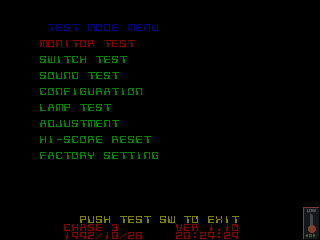
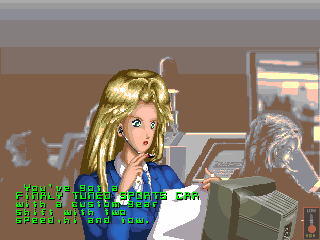







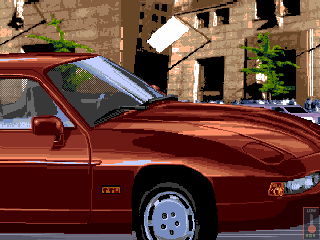









Next up is a prototype of Chase Bombers, this is significantly different from the final retail version and seems very glitchy, including a number of bad (placeholder?) sprites and bad colours for many objects. It is unclear at this point if all these glitches happen on the PCB or not. It’s clearly a development revision, and seems unlikely it was used by the public even for testing. Hopefully we can get a video of the original PCB running at some point.
You can see the rear view mirror at the top of the screen in the proto (moved to be nice little indicators at the bottom in the final) and different placement of most UI items. There’s no manual / automatic selection, and even test mode is a mess when it comes to button mappings / options working. This is clearly an early build in the middle of development.




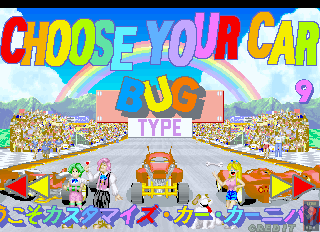



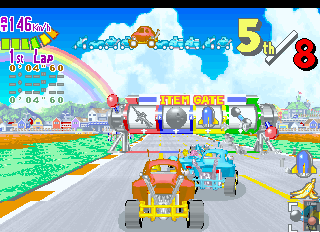



There was also a Cadash prototype, unfortunately large parts of the PCB, including many roms were covered in a layer of epoxy. For the time being I’m using the graphic + sound roms from the final game to run this, it’s possibly Taito only covered the PCBs with epoxy once the final mask roms etc. had been put into development (to prevent further changes to the graphics) because it does *appaer* to work with the final graphics, unlike the above protos which have and need different everything!
I’m not sure exactly what the changes are, clearly it’s less polished, and doesn’t seem to have working link-up code yet, nor a complete attract sequence, but I’m not really familiar with the original game. Clearly the translation differs slightly, and the placement of some UI elements like the time is moved too. The behavior in attract mode seems to suggest some game features (magic use?) might be different too but I’m not sure.




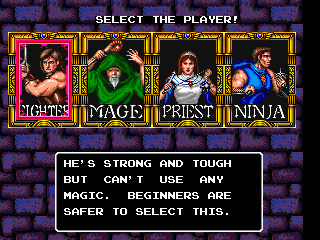



Moving away from Taito there is also a prototype of Capcom’s 1942. This runs on significantly different hardware to the final game, including different port addresses for almost everything (for some reason the test mode shows the addresses for the regular retail board, but the code is clearly incomplete)
Instead of using PROMs for the colours this uses Palette RAM, with a single look-up prom for sprite colours (same as the final game) Background colour banking is therefore done by writing a new palette rather than a bank register. The I/O mapping is also different as mentioned, the sprite format is different too.
Gameplay-wise you can also tell it’s a proto, there are some flaws in the design, for example the powerups enemies drop don’t move down the screen, they simply stay where they get dropped, this actually (rather frequently) makes them impossible to pick up because your plane can’t move the full area of the screen, oops! Sadly the PCB has sustained a heavy blow at some point in the past and the window on the sound rom is smashed, the game works fine with the retail rom, and it’s possible it was the same, but we’ll probably never know for sure as these protos are almost certainly one-off builds.







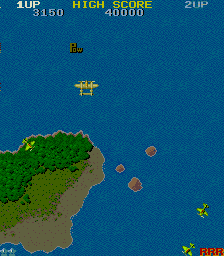
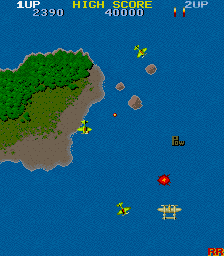

He also had alt versions of “4 en Raya”, “The First Funky Fighter” and “Brick Zone” which have been added, although it isn’t immediately obvious if those are prototypes. 4 en Raya and Funky Fighter were added and work. Brick Zone has version 1.1 strings in the ROM (the working versions in MAME are 4.0 and 5.0) but also has different protection, hopefully Luca will look at it as he did an excellent job with the Suna games / sets we have emulated right now.
The last board was a Data East Cobra Command (the Laserdisc game). This is also possibly a proto or the Japanese version (although it had English labels stating Cobra Command) and has significantly less graphic data than the other sets in the driver. It doesn’t work, and it’s entirely possible that when it does it will need another Laserdisc that no longer exists. I’m not in any way familiar with the LD hardware types so somebody else will need to take care of that.
Keep in mind this was over 16-hours of dumping work for the person involved (there were 62 roms on the Chase Bombers PCB alone) and also only possible thanks to the kindness of Unigame in allowing for his collection to be dumped. Obviously when dealing with prototypes like this you’re seeing things you’ll probably never see again, boards that were simply left-over from testing and development cycles with unique, often buggy revisions of code on them, but if you like to study that kind of thing then it’s all part of a fascinating process showing how the games came to be and in some cases (like 1942) how the hardware also evolved during that process. There’s still more where these came from!
The Choutetsu Brikin’ger – Iron clad have darker colours too. :)
Iron Clad only has darker colours when set to Asia / Europe, I think it’s a bug in the game (and possibly why it ended up not being released)
run it with “-bios japan” or “-bios us” for correct colours.
The NeoCD version is the same.
Thank you.
Is there a reason so many prototypes are surfacing all of a sudden?
Also is there a reason Model 2 and 3 never see much progress, I can understand they may not run too great even if they were fully working, but it just seems strange as Konami and Taito’s late 90’s hardware still seem to get looked at while these two are almost ignored.
I know there are other emulators for these, but the presence of standalone emulators has never seemed like a issue for mame.
Please extend thanks to the people involved, these are really exciting additions to MAME!
Thanks for the updates, Haze!
A stash of prototype boards was found (or rather the owner of a stash of prototype boards was open to having them dumped) simple as that really.
There’s actually all sorts in there, there’s a Spy Hunter that looks a lot like the 1942 PCB but is really bizzare, has Bally Midway markings, but also an ’85’ date (well after the game release) so I doubt it’s a proto, but at the same time the hardware changes are so significant it seems far too much effort for a bootleg (runs in non-interlaced mode, completely redone cheaper sound system etc.) It appears to have been made in Spain, but was with all these prototypes, possibly a licensed cost reduced version for foreign markets?
MAME doesn’t really do a good job of 3D stuff, certain devs have ElSemi’s model 2 code, so others don’t really want to waste their time reinventing the wheel, but the devs who have the code aren’t doing it. Model 3 again I believe we have permission to use whatever we want from Supermodel (given the developer has close connections with MAME) but there’s nobody doing it. One of the reasons I can’t leave MAME behind is because I know nobody will pick up what I leave, it will just get neglected.
There’s a complete lack of developers, not just in MAME but in many projects where serious work needs doing rather than just ‘fluff’ See the recent talk about the Linux Kernel and how the dev team there isn’t seeing any fresh blood either. People are coming through with the wrong type of programming skills for something like MAME these days, you just get a bunch of kids thinking they’re awesome because they can program fancy graphical effects with shaders, or write a flashy but functionless front-end with high level tools none of which is really useful to improving the core emulation of systems.
Thanks to all involved. A fan of 1942 so it will be interesting to play a proto of it, even if the differences are only small.
Did any of the devs ever think of teaching the principles of reverse engineering this hardware and coding for MAME?
I suspect a lot of this stuff is done on a case by case basis, but there must be some things in common that could be taught as a solid foundation.
If the developers could pass on the benefits of their expertise over the years then others might be able to pick up the torch.
Great additions!
Don’t worry about the numerous haters you have in forums. You are doing a really valuable work with MAME and we, simple users, deeply appreciate it.
actually the 1942 is confusing like Spy Hunter, seems almost like a bootleg (the PCBs are almost identical), but then why would it contain bugs like an unfinished game..
i’ve asked around and there is somebody else with a copy of the same 1942 and Spy Hunter PCBs in Spain… which makes sense because that seems to be the intended audience for these.
A tutorial would go a long way.
Also adding in these protos have they improved the emulation of existing games any? Have they yielded any new cool info about the hardware. For example maybe a buggy bit of code that was ripped out was using some feature of the existing hardware?
Thank you Haze and to all involved.
Good to see some Taito and Capcom prototypes from the golden age seeing the light of day and being saved for future reference in MAME and UME.
Also looking forward to the coming year in arcade game emulation and hopefully seeing some more progress on the decapsulation and reading of protection chips as well as the correct emulation of dipswitches and screen flipping for cocktail cabinets.
Kind regards to the Mame Devs and the few that submit games or donate towards emulation.
Tingoes.